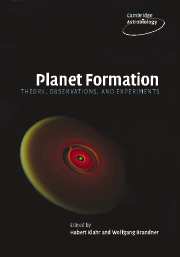Book contents
- Frontmatter
- Contents
- Preface
- Acknowledgments
- 1 Historical notes on planet formation
- 2 The Formation and Evolution of Planetary Systems: placing our Solar System in context
- 3 Destruction of protoplanetary disks by photoevaporation
- 4 Turbulence in protoplanetary accretion disks: driving mechanisms and role in planet formation
- 5 The origin of solids in the early Solar System
- 6 Experiments on planetesimal formation
- 7 Dust coagulation in protoplanetary disks
- 8 The accretion of giant planet cores
- 9 Planetary transits: a first direct vision of extrasolar planets
- 10 The core accretion–gas capture model for gas-giant planet formation
- 11 Properties of exoplanets: a Doppler study of 1330 stars
- 12 Giant-planet formation: theories meet observations
- 13 From hot Jupiters to hot Neptunes … and below
- 14 Disk–planet interaction and migration
- 15 The brown dwarf–planet relation
- 16 Exoplanet detection techniques – from astronomy to astrobiology
- 17 Overview and prospective in theory and observation of planet formation
- References
- Index
7 - Dust coagulation in protoplanetary disks
Published online by Cambridge University Press: 14 September 2009
- Frontmatter
- Contents
- Preface
- Acknowledgments
- 1 Historical notes on planet formation
- 2 The Formation and Evolution of Planetary Systems: placing our Solar System in context
- 3 Destruction of protoplanetary disks by photoevaporation
- 4 Turbulence in protoplanetary accretion disks: driving mechanisms and role in planet formation
- 5 The origin of solids in the early Solar System
- 6 Experiments on planetesimal formation
- 7 Dust coagulation in protoplanetary disks
- 8 The accretion of giant planet cores
- 9 Planetary transits: a first direct vision of extrasolar planets
- 10 The core accretion–gas capture model for gas-giant planet formation
- 11 Properties of exoplanets: a Doppler study of 1330 stars
- 12 Giant-planet formation: theories meet observations
- 13 From hot Jupiters to hot Neptunes … and below
- 14 Disk–planet interaction and migration
- 15 The brown dwarf–planet relation
- 16 Exoplanet detection techniques – from astronomy to astrobiology
- 17 Overview and prospective in theory and observation of planet formation
- References
- Index
Summary
Introduction
According to the core-accretion model for planet formation, the building blocks of planets are formed by the coagulation of dust grains, growing from the initial sub-micron sizes inherited from the interstellar medium to the 100 kilometer sizes of full-grown planetesimals. This is a growth process over 12 orders of magnitude in size and 36 orders of magnitude in mass. The physics of dust is of crucial importance for the study of planet formation. It also plays a major role in the structure and evolution of protoplanetary disks, since the dust carries most of the opacity of the dust–gas mixture in these disks and provides the surface for chemical reactions. Moreover, infrared and (sub)millimeter observations of dust continuum emission from these disks can be used as a powerful probe for the disk structure and mineralogical composition. A deep understanding of the physics of dust and the coagulation of grains is therefore of paramount importance for the study of the formation of planets and the circumstellar disks in which they are formed.
The study of grain coagulation and the formation of planetesimals has a long history. At the start of the twentieth century an equation for coagulation of colloidal particles was formulated by Smoluchowski (1916), though not related to astrophysical applications. The continuous form of that equation was later used to study the size distribution of fog particles in the Earth's atmosphere (Shumann, 1940).
- Type
- Chapter
- Information
- Planet FormationTheory, Observations, and Experiments, pp. 112 - 128Publisher: Cambridge University PressPrint publication year: 2006
- 8
- Cited by



